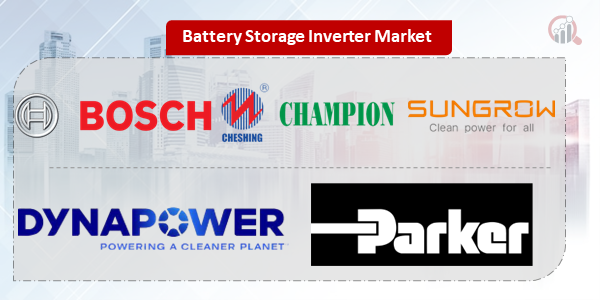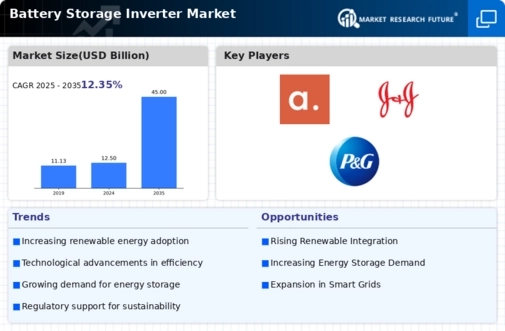Top Industry Leaders in the Battery Storage Inverter Market

*Disclaimer: List of key companies in no particular order
Top listed companies in the Battery Storage Inverter industry are:
Robert Bosch GmbH
CLOU
Zhicheng Champion
SUNGROW
Dynapower
Parker-Hannifin Corporation
TRIED
Eaton
SMA
KACO
ABB
Princeton
Powering the Switch: Exploring the Competitive Landscape of the Battery Storage Inverter Market
Beneath the sun-drenched panels of solar farms and the whirring blades of wind turbines lies a hidden battlefield – the battery storage inverter market. This multi-billion dollar arena hums with activity, as established giants, nimble innovators, and regional specialists grapple for a share in the future of energy storage and management. Let's delve into the key strategies, market dynamics, and future trends shaping this dynamic landscape.
Key Player Strategies:
Global Titans: Companies like ABB, Schneider Electric, Siemens, and SMA Solar leverage their extensive reach, diverse product portfolios, and strong relationships with major energy companies and utilities to maintain their dominance. They cater to a wide range of applications, from residential off-grid systems to large-scale grid-connected installations, offering various inverter types (single-phase, three-phase) and advanced features like bi-directional charging and grid stabilization capabilities. ABB's Power Conversion Systems portfolio showcases their focus on comprehensive energy solutions across the value chain.
Technology Disruptors: Startups like Sonnen, sonnenBatterie, and Tesla are disrupting the market with innovative inverter technologies like AI-powered energy management, cloud-based monitoring, and seamless integration with smart home systems. They cater to tech-savvy customers seeking intelligent energy solutions, microgrid capabilities, and enhanced user experience. Tesla's Powerwall inverter exemplifies their focus on residential energy storage and integration with electric vehicle charging.
Cost-Effective Challengers: Chinese manufacturers like Sungrow, BYD, and Huawei are making waves with competitively priced inverters, targeting cost-sensitive markets in developing countries. They focus on affordability and basic functionality, often partnering with local governments and project developers for market access. BYD's Battery-Box inverters exemplify their focus on budget-conscious solutions for grid-connected energy storage.
Niche Specialists: Companies like SMA America, SolarEdge, and Fronius excel in specific segments like commercial rooftop installations, high-efficiency inverters for demanding applications, and customized solutions for off-grid communities. They offer specialized expertise, modular designs, and local market knowledge for a defined customer base. SolarEdge's inverters with smart optimizers showcase their focus on maximizing efficiency and performance in complex solar systems.
Factors for Market Share Analysis:
Product Portfolio Breadth: Offering a diverse range of inverter types for various applications (residential, commercial, utility-scale), power capacities, and functionalities (bi-directional charging, islanding capability) caters to a wider customer base. Companies with comprehensive portfolios gain an edge.
Technological Innovation: Investing in R&D for next-generation technologies like high-frequency switching, advanced safety features, and intelligent energy management algorithms is crucial for staying ahead of the curve. Companies leading in innovation attract premium contracts and early adopters.
Cost and Affordability: Balancing advanced features with competitive pricing is vital for mass adoption, particularly in cost-sensitive markets. Companies offering affordable solutions without compromising performance or reliability stand out.
Quality and Reliability: Ensuring robust materials, precise manufacturing, and rigorous quality control is paramount for system longevity and safety. Companies with reliable track records and high-quality products gain trust and market share.
New and Emerging Trends:
Focus on Grid Modernization: Developing inverters compatible with microgrids and virtual power plant platforms contributes to grid resilience, stability, and integration of renewable energy sources. Companies specializing in grid integration solutions stand out in this evolving energy landscape.
Integration with Artificial Intelligence: Utilizing AI for real-time demand forecasting, optimal energy management, and predictive maintenance unlocks new efficiencies and enhances system performance. Companies embracing AI-powered solutions cater to the increasing demand for smart energy management.
Focus on Distributed Energy Resources: Providing modular, scalable inverter solutions for distributed solar projects and rooftop installations supports decentralized energy production and empowers local communities. Companies specializing in distributed energy solutions attract growing customer interest.
Focus on Sustainability and Recycling: Utilizing recycled materials, adopting eco-friendly manufacturing processes, and minimizing waste throughout the production and disposal process are becoming increasingly important. Companies demonstrating environmental commitment attract responsible investors and potential regulatory benefits.
Overall Competitive Scenario:
The battery storage inverter market is a dynamic and complex space with diverse players employing varied strategies. Established giants leverage their reach and diverse portfolios, while technology disruptors introduce innovative solutions for smart energy management and grid integration. Cost-effective challengers cater to budget-conscious buyers, and niche specialists excel in specific segments. Factors like product portfolio, technological innovation, affordability, and reliability play a crucial role in market share analysis. New trends like grid modernization, AI integration, distributed energy resources, and sustainability offer exciting growth opportunities. To power the switch to a sustainable future, players must prioritize innovation, cater to diverse energy needs, embrace green practices, and explore data-driven solutions. By delivering reliable power with adaptability and strategic partnerships, they can secure a dominant position in this ever-changing landscape
Latest Company Updates:
Robert Bosch GmbH: (Oct 2023) Partnered with Sonnen, a leading German energy storage company, to develop and manufacture advanced battery storage inverters for residential and commercial applications. (Source: Sonnen press release)
CLOU: (Dec 2023) Announced a new series of high-voltage battery storage inverters for grid-scale applications, offering high efficiency and modularity. (Source: CLOU press release)
Zhicheng Champion: (Nov 2023) Unveiled a new generation of low-cost, high-efficiency inverters for residential and small commercial energy storage systems. (Source: Zhicheng Champion website)
SUNGROW: (Sep 2023) Launched its "PowerTitan" series of megawatt-scale battery storage inverters for large-scale energy projects. (Source: SUNGROW website)

